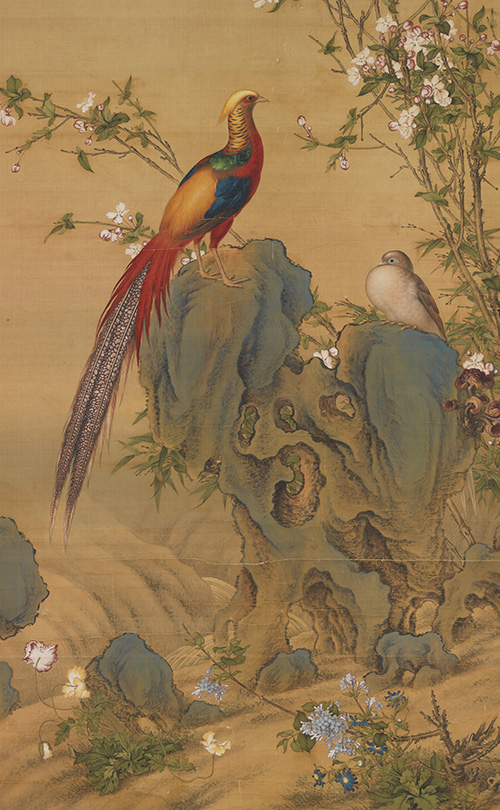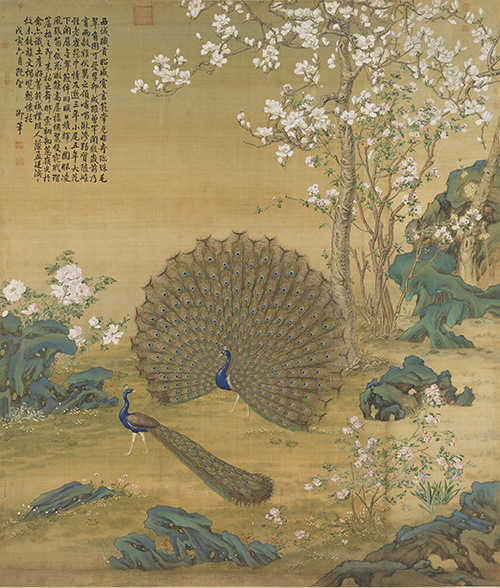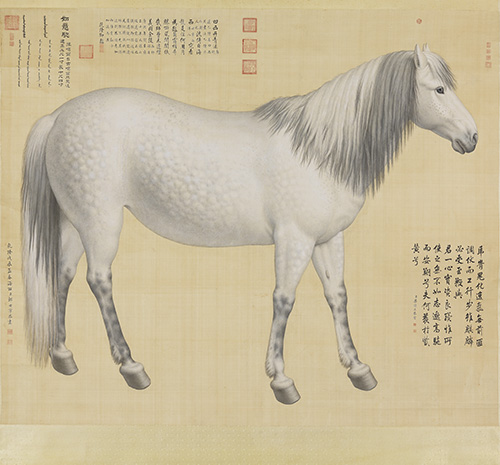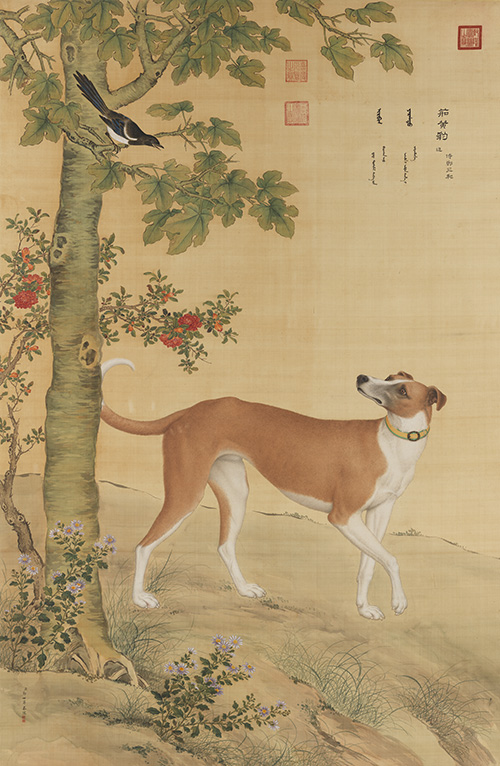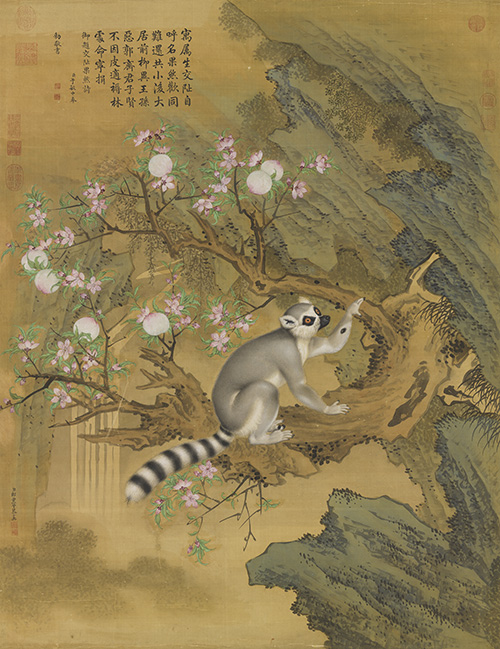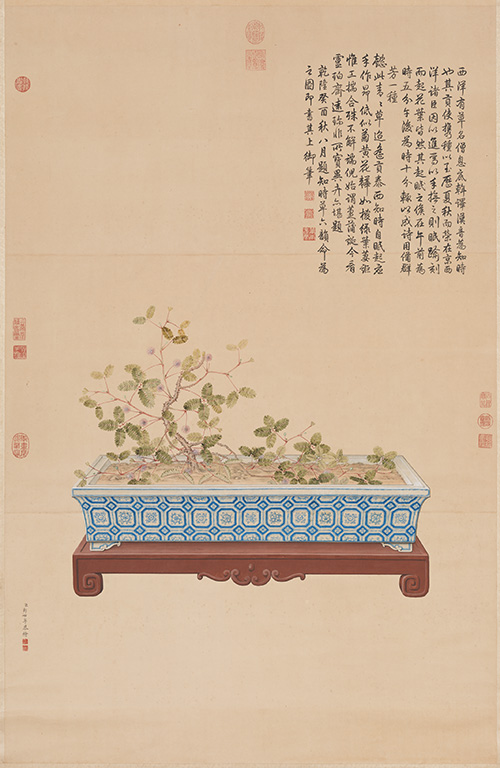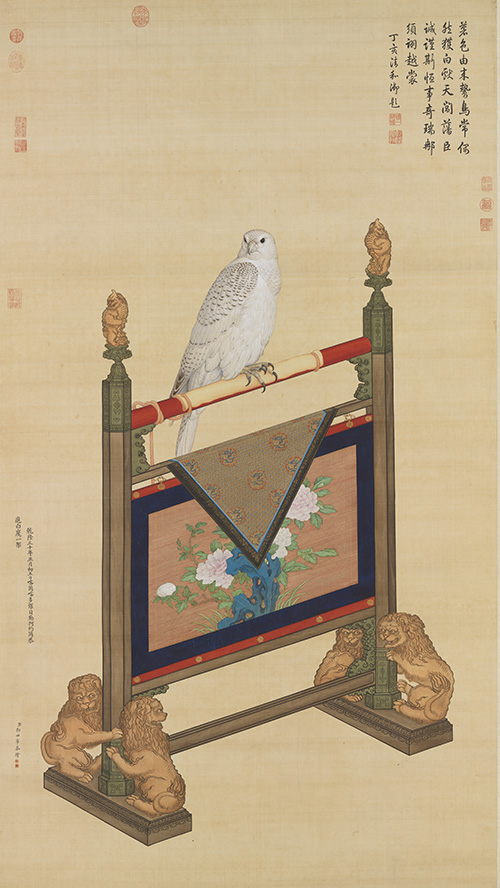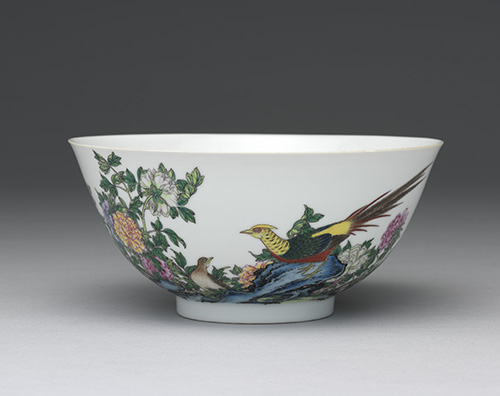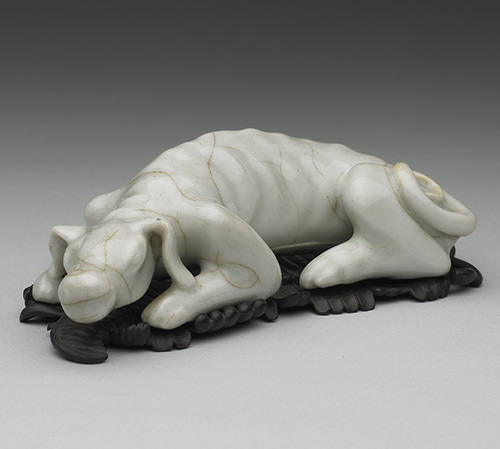Giuseppe Castiglione was ordered to portray exotic birds of prey, dogs, and steeds presented as tribute to the Qing court by Mongolian nobility and tributary states. Done on large scrolls, they have a grand and majestic presence. His depictions of ten steeds individually and four Afghan horses in a handscroll, for example, all bear imperial texts with titles in various languages used at court. This theme presents the exchange that took place between the Qing court and other peoples and states in winning over the latter and praising the power and prosperity of the former. Castiglione also collab-orated with other court artists on various paintings depicting golden pheasants, peacocks, falcons, and even a lemur, the animals all accurately portrayed and true to life. The lines are meticulous and fluid, the coloring lifelike and refined, fully reflecting Castiglione's solid training and accomplish-ment in painting from life. This type of work also acts as a period trait for the mutual learning and cooperation among Chinese and Western painters at the Qing court under the Yongzheng and Qianlong emperors.
Lang Shining (Giuseppe Castiglione, 1688-1766), Qing dynasty
Golden Pheasants in Spring
- Hanging scroll, ink and colors on silk
- 169.2 x 95.2 cm
This scroll portrays Chinese flowering crab apple in full bloom with a pair of golden pheasants (one male and the other female) perched on garden lake rocks by flowing water. The flowers form a brocade with exotic birds, auspicious spirit fungus, and bamboo all being metaphors to convey good fortune and longevity. The golden pheasant cock is shown with its bright and beautiful plumage, Giuseppe Castiglione using white lines to highlight the shine on its feathers for rich luster but without shadows for its form. The crab apple blossoms and spirit fungus are painstakingly colored with variations of light and dark as well. The landscape is rendered more with the Chinese use of brush and ink, but with exceptional attention paid to the detail. Even overlapping crab apple blossoms and bamboo in the background can be distinguished through the holes in the rock. The composition of this scroll is also more complex than that seen in "Myriad Longevity in an Everlasting Spring," indicating that the landscape is no longer merely a background for plants or animals.
Lang Shining (Giuseppe Castiglione, 1688-1766), Qing dynasty
Peacock Spreading Its Tail Feathers
- Hanging scroll, ink and colors on silk
- 328 x 282 cm
The male peafowl, or peacock, is renowned for its circular display of long and opulent tail feathers, which can reach several feet in length over five years. The feathers are usually kept folded behind its body, but when expanded for display, they shine with iridescent beauty and dazzling "eye" patterns. This painting is a scene in a palatial garden designed with "blue-and-green" rocks as well as magnolia, peony, and cherry apple blossoms, further conveying the traditional auspicious idea of "wealth and nobility in halls of jade.
In the sixth lunar month of the Qianlong 23rd year (1758), Kumul from the western regions presented peacocks as tribute, the emperor composing poetry on "Peacock Spreading Its Feathers," which is transcribed on this work. On the twelfth day of the seventh month of that year, the Ruyi Hall section of the imperial workshop archives records that Giuseppe Castiglione did a large hanging scroll painting on white silk of a peacock spreading its tail feathers with background scenery by the eighteenth-century artists Fang Cong and Jin Tingbiao. The Qianlong emperor's instructions for the painting explicitly state that it should represent a "fusion" of Chinese and Western painting.
Lang Shining (Giuseppe Castiglione, 1688-1766), Qing dynasty
Ten Steeds ("As-You-Wish" Piebald)
- Hanging scroll, ink and colors on silk
- 230.5 x 297 cm
The Dzungar people refer to several tribes of the Oirat Mongols located in the Ili area north of the Tian Shan Mountains. In 1743, Taiyiji Galdan Tsering dispatched an envoy to the Qing dynasty court to present a fine steed as tribute. Based on its docile character and hair color, the Qianlong emperor bestowed the auspicious name "As-you-wish Piebald" upon the horse, also ordering Giuseppe Castiglione to do a monumental painting of it. After completion, a member of the Hanlin Academy at court wrote an inscription of praise with information about the horse's name, dimensions, and origins, which were transcribed in Chinese, Manchu, and Mongolian. Also at the top of the painting is an imperial poem dated to the equivalent of 1748. Castiglione employed his consummate skills in European and Chinese painting to portray the majesty and bearing of this steed offered by tribal peoples, the hanging scroll being as much a grand record as it is an artistic rendering.
Lang Shining (Giuseppe Castiglione, 1688-1766), Qing dynasty
Ten Fine Hounds ("Tawny-Yellow Leopard")
- Hanging scroll, ink and colors on silk
- 247.5 x 163.7 cm
In 1747, Giuseppe Castiglione is recorded as being ordered to do ten paintings of fine hounds, which probably corresponds to this series in the National Palace Museum collection. The dogs appear like portraits, the paintings bearing inscriptions in Chinese, Manchu, and Mongolian with their names and who presented them as tribute. The rendering of the dogs is precise to the last detail, while the back-grounds are sketchier. For this reason, Castiglione is probably the artist who painted the dogs and oth-ers did the backgrounds, making this a collaborative project. "Tawny-Yellow Leopard," the hound shown in this painting, was presented by Vice Minister Sanhe (?-1773). The dog looks back at a mag-pie screeching from a paulownia tree above. Pomegranate and chrysanthemum blossoms also embellish the scene. The dog's gentle eyes and pleasingly lustrous hair make it appear quite lifelike. "Tawny Yellow" is the name of fine hound in the past, here not only alluding to antiquity but also to the color of the dog's hair.
Lang Shining (Giuseppe Castiglione, 1688-1766), Qing dynasty
Cochin Lemur
- Hanging scroll, ink and colors on silk
- 109.8 x 84.7 cm
A ring-tailed lemur is shown here on the trunk of a peach tree, its branches full of pink blossoms and with seven large fruit. Giuseppe Castiglione employed fine, short strokes of light ink with gradations of color to suggest light and volume. Depicting the alternating rings of black and white as well as the an-imal's fluffy fur, he has made an accurate and realistic portrayal here. The background landscape was done mostly with traditional "axe-cut" texture strokes to which blue-and-green washes were added with scattered fine dots of ink, representing the work of the court artist Jin Tingbiao (fl. 18th c.). At the top of the painting is a transcription of "Imperial Poetry on a Cochin Lemur," which was composed in Qianlong's 26th year on the throne, or 1761. That year was also the seventieth birthday of Qianlong's mother, Lady Niuhuru (1692-1777), so this work was probably painted specifically to bless her with a long life.
Lang Shining (Giuseppe Castiglione, 1688-1766), Qing dynasty
Time-Telling Plant from the West
- Hanging scroll, ink and colors on paper
- 136.6 x 88.6 cm
The time-telling plant ("touch-me-not" or sensitive plant, mimosa pudica) was originally native to the tropics in the Americas. With hairs and thorny stems, it blooms in summer and autumn with round pink blossoms. Its leaves are sensitive and just a slight touch will make them fold up and retract. On this painting of the plant is an imperial poem entitled "Six Rhymes on the Time-Telling Plant" from the eighteenth year of the Qianlong emperor's reign (1753), explaining how it was presented as tribute by Western missionaries and planted in the palace gardens, the Qianlong emperor ordering Giuseppe Castiglione to make a visual record of it. The plant is depicted using Western methods, Castiglione showing it in a planter on a wooden stand against a blank background similar to a manual with illustrations from life, serving both for appreciation and as a record. The large porcelain planter features a pattern in underglaze-blue, the wood stand below having inward-curving feet with a geometric manner. The hues of the porcelain and wood vary in luster to give them a volumetric effect.
Lang Shining (Giuseppe Castiglione, 1688-1766), Qing dynasty
White Falcon
- Hanging scroll, ink and colors on silk
- 179.9 x 99.2 cm
This trained falcon appears at the court perched on a stand with gleaming white plumage speckled gray and brown on the back of its head and wings. The red crossbar has a soft leather pad for the falcon to grip and protect its talons. Below, the stand is draped with a piece of brocaded cloth over the screen to prevent the rope tied to the bird's leg from becoming tangled on the crossbar. The stand, though quite detailed and realistic, is not from the hand of Giuseppe Castiglione, who depicted the falcon. According to a record from the archives of the imperial workshops, in the first lunar month of the year this falcon was submitted to the court as tribute (1765), the painter Yao Wenhan (fl. ca. 1743-1774) took part in rendering the stand, screen, and brocade of a work.
The Khalhka Mongol Beile Ayur presented this white falcon as tribute in that year, this hanging scroll representing the latest signed work by Castiglione. He did it at the age of 77, dying the following year of illness in Beijing.
Qing dynasty, Yongzheng reign
Porcelain bowl with peonies and pheasants in falangcai painted enamels
Surviving as a pair, this work is recorded in the 1835 archives for the court display of enamel, glass, Yixing, and porcelain wares as "Pair of porcelain-body court bowls with painted enamels of golden pheasants of prosperity on a white background." The other bowl is in the collection of the Beijing Pal-ace Museum. The surface of this bowl shows the colors of the golden pheasant and its pose as similar to those seen in Giuseppe Castiglione's "Golden Pheasants in Spring." It highlights the possible rela-tionship between court painting and porcelain decoration.
Qing dynasty, 18th century
Celadon dog
The details of the skin and bones for this celadon dog reveal the attention paid by the artisan in bring-ing out the features of its body. Due to the similarity in terms of form and pose with Giuseppe Castiglione's portrayal of a dog named "Sudden-flight Magpie" in his "Ten Fine Hounds," it suggests the possibility that the production of such "portraiture porcelain" was connected to Western missionaries in the eighteenth century.
